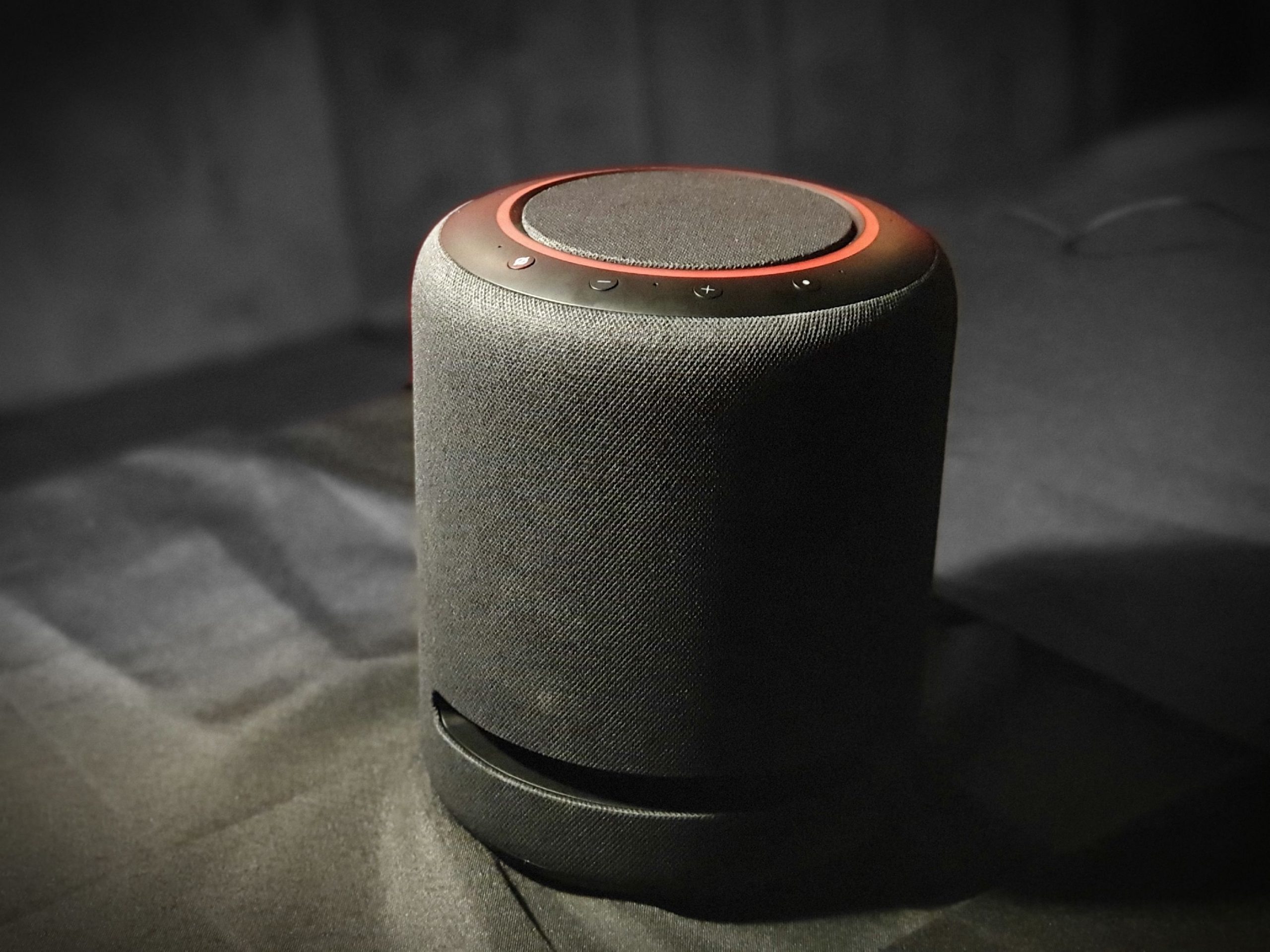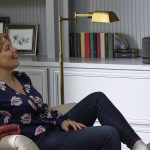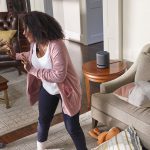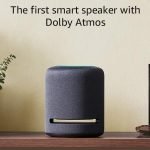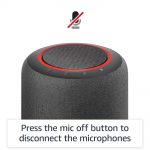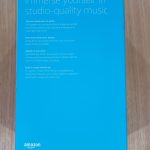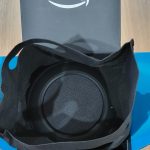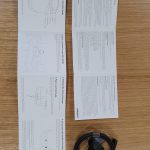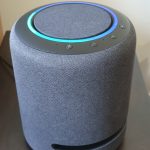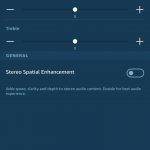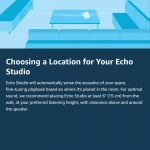The launch of the new Echo Studio speaker by Amazon gives Australians a strong new contender to compare and contrast with other in home mains powered smart speaker options such as Sonos, Google, Bose etc.
Until recently Australians who wanted to listen to an Alexa powered speaker that sounded good when playing music had to buy a third party Alexa enabled speaker brand like Sonos.
That isn’t true anymore because the Echo Studio is a very capable speaker at an affordable price point of $329.
Specifications, Unboxing and Setup
Inside there are 5 speakers covering every direction except directly behind the Echo Studio.
Facing down is a strong 5.25″ downward firing woofer for bass, the slot near the bottom of the speaker aims to maximise bass output.
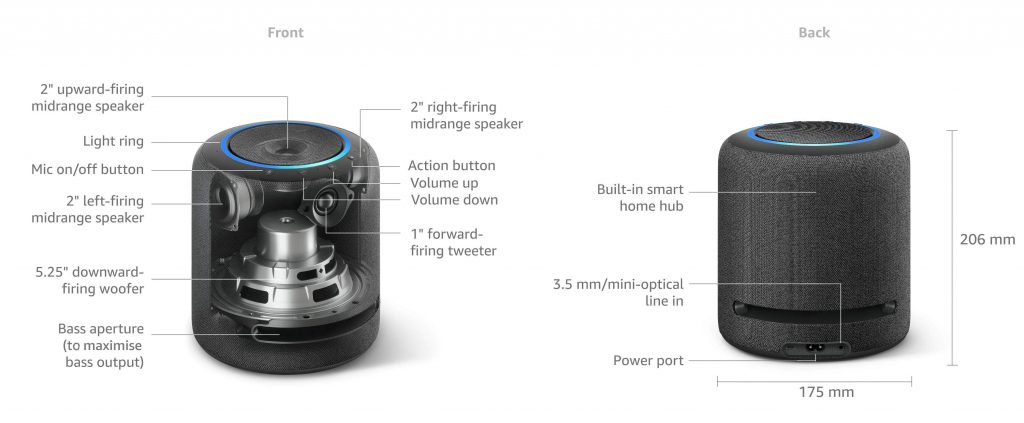
Facing up is a 2″ mid-range speaker which especially comes into play when playing Dolby ATMOS or other supported 3D audio. This upward firing speaker is why you shouldn’t place the Echo Studio anywhere like inside a bookshelf that has a flat surface close to the top of the speaker. To do its job properly the upward firing speaker aims to balance sound off your ceiling.
On both the left and right-hand sides there are 2″ mid-range speakers. These sideways firing speakers require at least 15cm of free space between them and the next object, ideally a bit more space than that on the left and right of the Echo Studio. To round things off there is a 1″ forward firing tweeter.
| Size & Weight | 206 mm height, 175 mm diameter, 3.5 kg |
| Audio | Three 2” mid-range speakers, one 1” tweeter, one 5.25” woofer with bass aperture to maximise bass output |
| Amplifier | Peak output 330W; 24-bit DAC; 100 kHz bandwidth |
| Supported audio formats | FLAC, MP3, AAC, Opus, Vorbis, Dolby Digital, Dolby Digital Plus, Dolby Atmos, Sony 360 Reality Audio/MPEG-H; includes support for CD Quality (16-bit) and Hi-Res (24-bit) |
| Supported music streaming services | Amazon Music, Apple Music, Spotify, iHeartRadio, TuneIn |
| Automatic room adaptation | Analyses the acoustics of the room and continuously adjusts audio filters during music playback to optimise sound output regardless of placement (as long as the speaker mics are not muted). |
| Audio input | Combination 3.5 mm/mini-optical Toslink |
| Wi-Fi connectivity | Wi-Fi required. Dual-band Wi-Fi supports 802.11 a/b/g/n/ac (2.4 and 5 GHz) networks. Does not support connecting to ad-hoc (or peer-to-peer) Wi-Fi networks. |
| Zigbee connectivity | Built-in Zigbee smart home hub supports Zigbee light bulbs, locks, sensors, plugs, and in-wall switches. |
| Bluetooth connectivity | Advanced Audio Distribution Profile (A2DP) support for audio streaming from your mobile device to Echo or from Echo to your Bluetooth speaker. Audio/Video Remote Control Profile (AVRCP) for voice control of connected mobile devices. |
Amazon knows how to do the setup process well, I found it was literally as easy as the steps in the picture below. You can choose to connect to either 2.4Ghz or 5Ghz WiFi. The power socket and 3.5mm/mini optical input are at the back.

Once setup Echo Studio can be used with Amazon Music, Apple Music, Spotify (free or paid), Tidal, Deezer, iHeartRadio and TuneIn as well as Bluetoooth audio from a phone or tablet.
What It Doesn’t Do Well
Unfortunately Amazon decided to enable “Stereo Spatial Enhancement” by default for all standard stereo audio that you play with the Echo Studio.
Amazon meant well but this attempt to give normal stereo music the “space clarity and depth” of a Dolby Atmos recording doesn’t work. It has different impacts depending on the kind of song but examples of negative results include instrumentation overpowering vocals and a wider sound-stage than normal with a processed kind of sound.
To turn it off you have to go quite deep into the Alexa app settings on your phone/tablet. Alexa app > Devices > Echo & Alexa > Echo Studio > Audio Settings > disable “Stereo Spatial Enhancement”. Once this is done songs sound as they should.
Amazon has confused some overseas buyers of the Echo Studio because in the USA Amazon Music has a “HD” subscription level that takes advantage of the Echo Studio’s support for Dolby Atmos mastered songs and Sony 360 Reality Audio mastered tracks. In Australia we do not have that option yet and Amazon will not comment on if it will ever be available here.
American reviews of the Echo Studio also often mention how two of them can be used as true right/left separated home theatre speakers for listening to audio from your TV. However this is only possible when the Echo Studio wirelessly connects to Amazon’s Fire TV cube, Fire TV Stick 4K or Fire TV box. None of these are offered for purchase in Australia and Amazon cannot comment about whether they will ever be.
Lastly like all speakers if you place the Echo Studio a lot lower or higher than your ears are when listening to the speaker, it won’t sound as good. This is especially the case if the speaker is located too low on a stand so it’s audio output gets absorbed by surrounding furniture, sofas etc before it can reach you.
What It’s Good At
Once you’ve turned “Stereo Spatial Enhancement” off the Echo Studio plays all forms of audio well from talk radio to podcasts and music. Primarily the music I listened to was from Amazon Music Unlimited trial subscription and by streaming various radio stations including RRR Melbourne.
To give you an idea of what I like listening to its mostly Rock and Pop music from the 70’s 80’s and 90’s such as Fleetwood Mac, Elton John and Split Enz with some newer tracks like Youngblood (5 Seconds of Summer) and Feel It Still by Portugal The Man.
Since the automatic room optimisation cannot be turned off the Echo Studio will sound a little different in your home compared to mine.
That said my testing shows that the Echo Studio can play all kinds of music as well as podcasts and talk radio quite well without distortion or needing to turn the volume up really high. I live in an apartment so found that it could easily fill our main living dining kitchen area on volume 4 or 5 out of 10.
If I had a powerpoint located on the other side of the room to place a second Echo Studio the music enjoyment would be even better. However just 1 is plenty for a 40 m² space as long as you position it well.
Interestingly Amazon flew in it’s Senior Manager, Audio Hardware Technology for the Australian launch event of the Echo Studio. Jan Abildgaard Pedersen is a specialist in DSP & Acoustic Technology and has previously worked at Bang & Olufsen.
This could explain why the Echo Studio is a similar shape to the B&O M3/M5 speakers. In my testing the Echo Studio sounded just as good as the B&O M5 speaker I purchased a few years ago, which is a pretty good achievement considering the Echo Studio costs less than half what I paid for the M5.
This shows how much audio technology has progressed since then. It should also be noted that Amazon probably isn’t making much if any profit on the Echo Studio by itself. A stand-alone hardware company like B&O has to make a decent profit margin on their speaker sales while Amazon can make profit off the speaker in the future through Amazon Music services subscriptions and voice shopping purchases from Amazon Shopping.
The Echo Studio looks a lot better than the first generation of Amazon speakers. Around all the sides it’s covered with acoustic fabric. On top there’s a plastic ring around the edge and the top firing mid-range speaker covered in acoustic fabric.
The plastic ring contains the 7 far field microphones that listen for your commands and are also used to automatically tune and optimise the speakers audio output for where your walls, furniture etc are. Don’t worry about needing to re-tune the speaker if you move it to a new location in your home, it will optimise by itself.
When it comes to controlling smart devices the Echo Studio manages to adjust, turn on and off IOT devices of various manufacturers (Philips Hue, Mirabella etc) without a problem.
Actually after comparing how Google and Alexa responded when told to control various smart devices, I now prefer Alexa and use it instead of Google to control my things by voice.
That’s because when I tell Google to turn things on/off it insists on repeating my command back to me eg: “Hey Google turn the TV plug on”, it talks back saying “sure turning on the TV plug”. In comparison Alexa just makes a soft confirmation beep to say that it’s doing the job.
Should You Buy the Amazon Echo Studio Speaker?
If your home is already part of the Amazon Alexa speaker ecosystem but you were missing a speaker that actually sounded good when playing music, then the Echo Studio is an obvious and easy recommendation to make.
If you’ve already spent money on some mid to high range Google assistant powered speakers then the Echo Studio is not suitable for you because it’s in an Amazon Alexa speaker ecosystem instead.
However if like the majority of Australians you only have a small Google Home Mini which is mostly used for listening to music and controlling smartphone devices then it’s worth considering defecting to the Amazon smart speaker ecosystem and buying the Echo Studio if you have $329 spare.
I’m actually going to do that myself by paying for a family subscription to Amazon Music Unlimited once my free trial finishes. Google has been threatening to kill off Google Play Music and force all its subscribers to use YouTube music instead which I don’t want to.
Amazon Music Unlimited has all the artists and tracks that I’m looking for with the added bonus that Amazon doesn’t randomly kill it’s services like Google is notorious for.
Furthermore the Amazon Music Unlimited mobile app can cast music to Google Home or Amazon Alexa speakers, which makes it easier to play music on smart speakers at friends and relatives places without needing to use battery sucking Bluetooth.
You can buy the Echo Studio for $329 from Amazon Australia or JB Hi Fi.
Disclosure Statement
Amazon has allowed Ausdroid to keep this speaker to continue testing Alexa and Amazon features as they evolve

